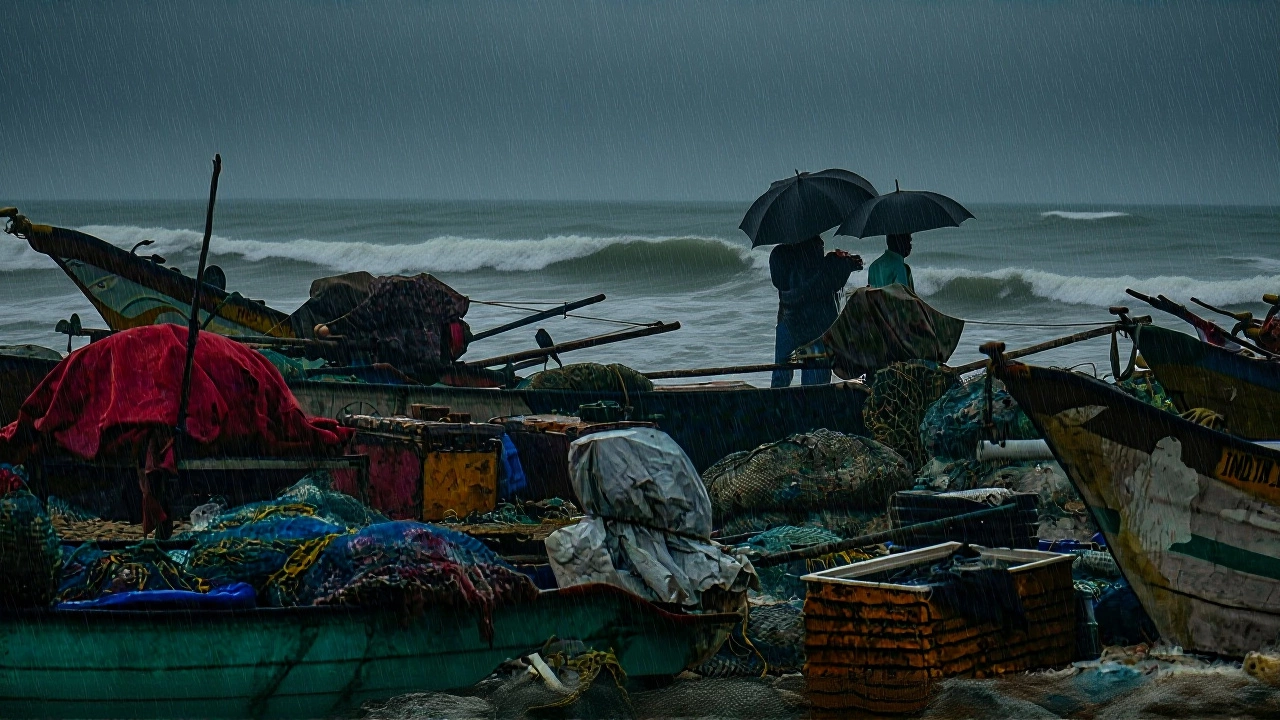When India Meteorological Department rolled out a cascade of red, orange and yellow warnings on October 21, 2025, residents across the southern state braced for what officials called an “exceptionally intense” northeast monsoon burst.
The alerts covered a swath of districts from the coastal belt to the inland plains of Tamil Nadu. In the capital, Chennai, streets that had just cleared from yesterday’s downpour began to flood again, while the Vaigai River in Madurai surged to near‑record levels.
Background: A Low‑Pressure System Over the Bay
A low‑pressure area that formed over the southwest Bay of Bengal late on October 20 started pulling moisture inland, fueling the northeast monsoon that typically peaks in October. Meteorologists at the Regional Meteorological Centre in Chennai warned that the system was likely to deepen further, meaning heavier rain for the next 48‑72 hours.
Historically, the same region has seen similar setups in 2015 and 2019, when rapid intensification led to flash floods across the delta. "We’re seeing a classic monsoon trough, but the sea‑surface temperatures are a few degrees higher than average," said Dr. Ananya Rao, senior climatologist at the Indian Institute of Tropical Meteorology.
Alert Overview: Who’s in the Red Zone?
- Red Alert: Villupuram, Cuddalore, Mayiladuthurai, Nagapattinam, Tiruvallur, Thanjavur, Pudukottai, Ramanathapuram – expected rainfall >20 cm in 24 hours.
- Orange Alert: Chennai, Tiruvallur, Chengalpattu, Kancheepuram, Kallakurichi, Ariyalur, Perambalur, Thoothukudi, Tirunelveli, Kanyakumari – 11‑20 cm.
- Yellow Alert: Tenkasi, Virudhunagar, Madurai, Sivaganga, Trichy, Thiruvannamalai, Ranipet – 5‑10 cm.
Even the adjoining Union Territory of Puducherry received a red warning, underscoring how the system respects political borders less than geography.
On‑the‑Ground Impacts
In Chennai, waterlogged arterial roads forced commuters onto makeshift footpaths. "My bus was stuck for two hours," complained Ramesh, a daily wage worker. Similar scenes unfolded in Thoothukudi where low‑lying markets were under ankle‑deep water.
Madurai’s Vaigai River crested at 8.4 m, prompting a flood alert that saw the district administration opening evacuation shelters in schools and community halls. The flash flood disrupted power supplies for more than 30,000 households.
Rural pockets reported mudslides on the foothills of the Eastern Ghats, with at least three minor landslips reported in Kallakurichi. Farmers fear that standing crops of paddy and millets could suffer losses exceeding ₹12 crore.

Official Responses
Chief Minister M.K. Stalin convened an emergency meeting with district collectors, police chiefs and health officials as the rain hammered the state. "Our priority is to safeguard lives and ensure that rescue teams are on standby," he said during a press briefing at the Secretariat.
The state disaster management authority deployed over 150 rapid response teams, equipped with high‑water trucks and portable generators. In Chennai, the corporation’s flood‑control cell activated the city’s pumping stations, moving an estimated 2.5 million liters of water to the Bay of Bengal.
The IMD press release, issued at 13:30 IST, urged residents in red‑alert districts to move to higher ground and avoid low‑lying roads. It also highlighted that visibility could drop below 100 m during the heaviest bursts, a serious hazard for drivers.
Future Outlook: How Long Will the Deluge Last?
Models suggest the low‑pressure system will linger over the Bay until at least October 24, gradually weakening as it moves eastward toward coastal Andhra Pradesh. The IMD expects “very heavy” rain to continue in Tamil Nadu and Kerala on October 22, tapering to “heavy” on the 23rd and “moderate” by the 25th.
While forecast confidence improves for the immediate 24‑hour window, the agency warned that beyond three days, accuracy drops sharply. Residents are therefore advised to keep monitoring official alerts via the IMD website or local radio.

Historical Context: Lessons from Past Monsoons
The 2015 northeast monsoon, which delivered over 30 cm of rain in Chennai within 48 hours, led to the city’s first ever “rain‑induced” road‑damage compensation scheme. In 2019, the state introduced the Coastal Flood Early Warning System, now credited with reducing flood‑related fatalities by roughly 18 %.
These precedents have shaped today’s response: quicker sandbag distribution, pre‑emptive school closures, and real‑time traffic rerouting via the Tamil Nadu Traffic Police’s app.
Key Facts
- Date of alert: 21 Oct 2025, 13:30 IST
- Red‑alert districts: 8 (Villupuram, Cuddalore, Mayiladuthurai, Nagapattinam, Tiruvallur, Thanjavur, Pudukottai, Ramanathapuram)
- Expected rainfall: >20 cm in 24 hours for red zones
- Key officials: CM M.K. Stalin, IMD, RMC Chennai
- Potential impacts: flooding, landslides, crop loss, traffic disruption
Frequently Asked Questions
What areas are most at risk of flooding?
Red‑alert districts such as Villupuram, Cuddalore and Ramanathapuram face the highest risk, with rainfall projected to exceed 20 cm in a single day. Coastal cities like Chennai and Thoothukudi are also vulnerable to water‑logging on main roads and low‑lying neighborhoods.
How is the government supporting affected residents?
The state disaster management authority has dispatched 150 rapid response teams, opened evacuation shelters in schools, and activated pumping stations in Chennai. Relief kits containing food, water and dry clothing are being distributed in the most affected panchayats.
When can we expect the rain to ease?
Meteorologists predict the heaviest rainfall will taper off by October 23, with moderate showers lingering into the weekend. However, the situation remains fluid, and residents should continue to follow updates from the IMD.
What should farmers do to protect their crops?
Agricultural officers are advising farmers to reinforce field bunds, relocate seedlings to higher ground where possible, and apply anti‑fungal sprays pre‑emptively. In districts like Thanjavur, the state has earmarked ₹3 crore for emergency irrigation support.
Will the rain affect travel plans in the region?
Roads in red‑alert zones are likely to remain closed or experience significant delays. The Southern Railway has cancelled several train services between Chennai and Tirunelveli until at least October 23. Travelers are urged to check real‑time traffic updates before heading out.
